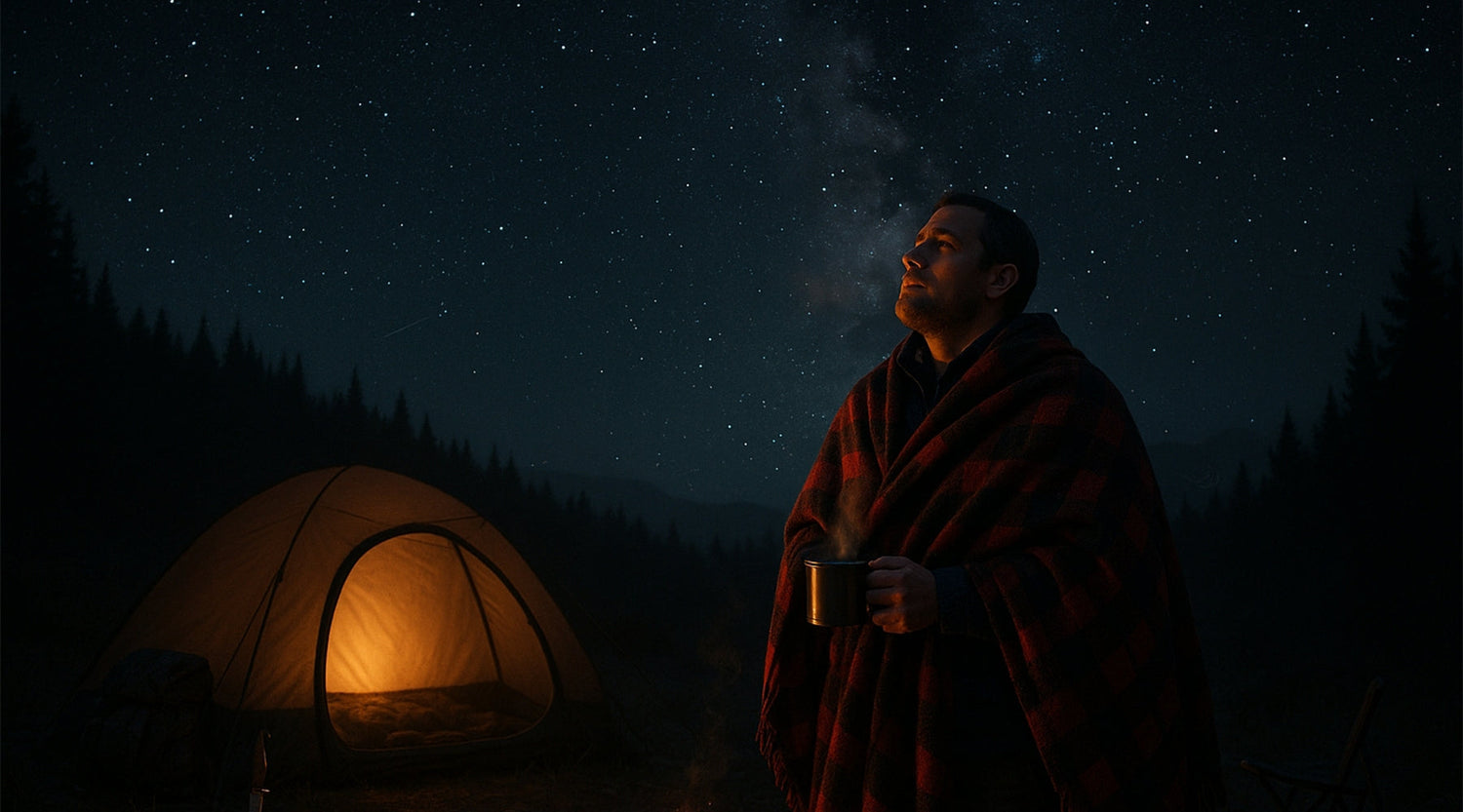Shooting stars are one of the best things that can happen in the night sky. Short streaks of light from these "shooting stars" are very interesting to look at because they show us how busy our solar system is. There are several good chances to see these things happen in 2025. This guide will tell you when and where to look for meteor showers, as well as how to get ready for the best view and make yourself comfortable while you watch.
What Are Meteor Showers?
Meteor showers, also known as "shooting stars", happen when Earth moves through trails of space dust and rock, usually from comets or asteroids. Meteoroids are these small space rocks that burn up as they hit Earth's atmosphere, leaving behind streaks of light. It looks like these meteors come from a single point in the sky during a shower. This point is called the source. The Zenithal Hourly Rate (ZHR) of a shower is a theoretical number of meteors per hour in ideal conditions. However, your view will rely on things like how dark your sky is and, most importantly, how bright the Moon is. A bright moon can easily make fainter meteors impossible to see.
2025 Meteor Shower Calendar and Viewing Tips
Several meteor showers are on the calendar for 2025. A few have already passed, but there are still many more to look forward to. It's always a good idea to check for the latest peak times closer to the date from reliable sources like NASA, the International Meteor Organization (IMO), or astronomy magazines such as Sky & Telescope, as predictions can get more precise.
Showers That Have Already Peaked in 2025:
- Quadrantids (Peak: January 3-4): This shower can produce up to 120 meteors per hour under ideal conditions and had generally good viewing this year after the waxing crescent moon set.
- Lyrids (Peak: April 22-23): A more moderate shower with 10-20 meteors per hour, the Lyrids had excellent viewing conditions in 2025 thanks to a waning crescent moon.
- Eta Aquariids(Peak: May 5-6): Known for fast meteors and a ZHR of 40-55 (especially in the Southern Hemisphere), this shower, linked to Halley's Comet, faced some interference from a fairly bright waxing gibbous moon.
Upcoming Major Meteor Showers in 2025:
Here’s what to look for in the rest of 2025:
Delta Aquariids (Southern)
- Typical Peak: Late July (around July 28-29)
- Typical ZHR: 15-20 (best for the Southern Hemisphere but visible from southern parts of the Northern Hemisphere)
- Parent Body: Comet 96P/Machholz
- 2025 Moon Phase: Good. The New Moon is on July 25th. So, around the peak (July 28-29), the Moon will be a thin waxing crescent (about 27% lit on the 29th). It will set early in the evening, leaving the sky dark for the best viewing hours later at night.
Perseids
- Typical Peak: Mid-August (around August 12-13)
- Typical ZHR: 50-100+ (often one of the year's best and most reliable showers, known for bright meteors)
- Parent Body: Comet 109P/Swift-Tuttle
- 2025 Moon Phase: Poor. The Full Moon is on August 9th. By the Perseids' peak, the Moon will be a bright waning gibbous (about 84% lit). This bright moonlight will make it hard to see many of the fainter meteors.
Draconids (Giacobinids)
- Typical Peak: Early October (around October 8-9)
- Typical ZHR: Usually low (~10), but can sometimes have surprise outbursts. Best seen in the early evening.
- Parent Body: Comet 21P/Giacobini-Zinner
- 2025 Moon Phase: Very Poor. The Full Moon is on October 7th. During the Draconids' peak, the Moon will be just past full and very bright (around 98% lit on the 8th, 93% on the 9th). This will make it very difficult to see these usually faint meteors.
Orionids
- Typical Peak: Mid-Late October (around October 21-22)
- Typical ZHR: 10-20 (known for fast meteors that can leave glowing trails)
- Parent Body: Comet 1P/Halley
- 2025 Moon Phase: Excellent. The New Moon is on October 21st. This means the nights around the Orionids' peak will be very dark, perfect for watching this shower if the weather is clear.
Leonids
- Typical Peak: Mid-November (around November 17-18)
- Typical ZHR: 10-15 (famous for producing meteor storms in the past, but no storm is expected in 2025)
- Parent Body: Comet 55P/Tempel-Tuttle
- 2025 Moon Phase: Excellent. The New Moon is on November 20th. Around the peak, the Moon will be a very thin waning crescent (8.5% lit on the 17th, 3.9% on the 18th). It will rise very late, so most of the night will be dark for watching the Leonids.
Geminids
- Typical Peak: Mid-December (around December 13-14)
- Typical ZHR: 120-150 (often the best and most reliable shower of the year, with bright, colorful meteors)
- Parent Body: Asteroid 3200 Phaethon
- 2025 Moon Phase: Very Good. The Last Quarter Moon is on December 12th/13th. During the Geminids' peak, the Moon will be a waning crescent and will rise late, around 2 a.m. local time. This means you'll have dark skies for several hours in the evening and early night.
Even when there isn't a major shower, you can often see a few sporadic meteors on any clear, dark night.
Where to Watch Shooting Stars

Your location makes a big difference. The key thing is to find a dark spot.
Rural Areas and National Parks:
Meteors are hard to see because city and neighborhood lights make the sky too bright. It's best to be in the country, a national park, or a place known for having dark skies. You can use websites like darksitefinder.com or lightpollutionmap.info to find good spots close to you.
Hilltops and Open Fields:
Choose a place where you can see the sky clearly, with no trees, buildings, or hills in the way. You can see the stars very well from an open field or a hilltop.
Northern vs Southern Hemisphere Locations:
There are places where you can see some showers better than others. Like, the Southern Delta Aquariids are best seen from the southern parts of the northern hemisphere, but people in the southern parts of the southern hemisphere can still see them. A lot of the time, the brighter the source is, the more meteors you'll see.
Dark Sky Preserves:
Official dark sky preserves and sanctuaries offer the best viewing circumstances. These protected spots don't let in any artificial light, which makes them great places to watch meteors.
How to Spot More Meteors: Observation Techniques
Once you've figured out the when and where, here's how to make the most of your viewing time.
Check Weather and Moon Conditions First:
Check the weather forecast before heading out, as clouds will ruin the show. Double-check the peak times and moon phase with reliable astronomy sources like NASA or the International Meteor Organization as the date approaches. If you're going to a remote spot, tell someone where you're going and when you expect to be back.
Give Your Eyes 30 Minutes to Adapt:
Your eyes are your best tool—no special equipment needed. Allow at least 20-30 minutes in complete darkness for your eyes to fully adapt. Avoid looking at bright lights, including your phone. If you need light, use a red-filtered flashlight as red light preserves night vision.
Scan 45-60 Degrees Above the Horizon:
Don't just stare at one spot; sweep your gaze across a large area of the sky. Look approximately 45-60 degrees above the horizon in the general direction of the radiant while maintaining a wide field of view.
Wait Through the Quiet Periods:
Meteors typically appear in bursts with quiet periods between. Stay focused during these lulls as the most spectacular meteors often appear unexpectedly after quiet stretches.
Tips for Comfortable Meteor Viewing
Watching meteors for a while can get uncomfortable if you're not prepared. Physical comfort is just as important as a clear view for an enjoyable experience.
Layer Clothing with Wind Protection:
Nighttime temperatures drop significantly, even in summer. Wear multiple thin layers instead of one thick layer. A wind-resistant outer shell, warm hat, gloves, and thick socks are essential, particularly for winter showers like the Geminids.
Bring a Reclining Chair or Sleeping Bag:
Your neck will strain from looking up for extended periods. Use a fully-reclining lawn chair or lie on a sleeping bag with a pillow to maintain a comfortable upward gaze without discomfort. Faux fur blankets from Cozy Bliss are excellent additions for both warmth and comfort—their plush texture provides superior insulation while being lightweight and easy to transport to viewing locations.
Pack a Thermos and Quiet Snacks:
Bring warm beverages like hot chocolate or tea in an insulated container. Include easily accessible, minimally noisy snacks like soft granola bars or nuts to maintain energy during long viewing sessions.
Apply Insect Repellent for Summer Showers:
For summer events like the Delta Aquariids or Perseids, apply insect repellent to exposed skin before settling in. Consider treating your clothes with permethrin for additional protection against persistent insects.
Limit Conversation and Screen Time:
While sharing the experience with others enhances enjoyment, minimize talking and eliminate phone use (except with red filters) to maintain dark adaptation and focus on the meteor display.
Prepare for a Night Under the Stars!
Meteor showers are one of nature's great free shows. By planning for the right time, finding a dark spot, and making sure you're comfortable, you can have a memorable night watching the sky. The rest of 2025 has some good opportunities coming up. So, make a plan to get outside, look up, and enjoy the view.




Dejar un comentario
Este sitio está protegido por hCaptcha y se aplican la Política de privacidad de hCaptcha y los Términos del servicio.